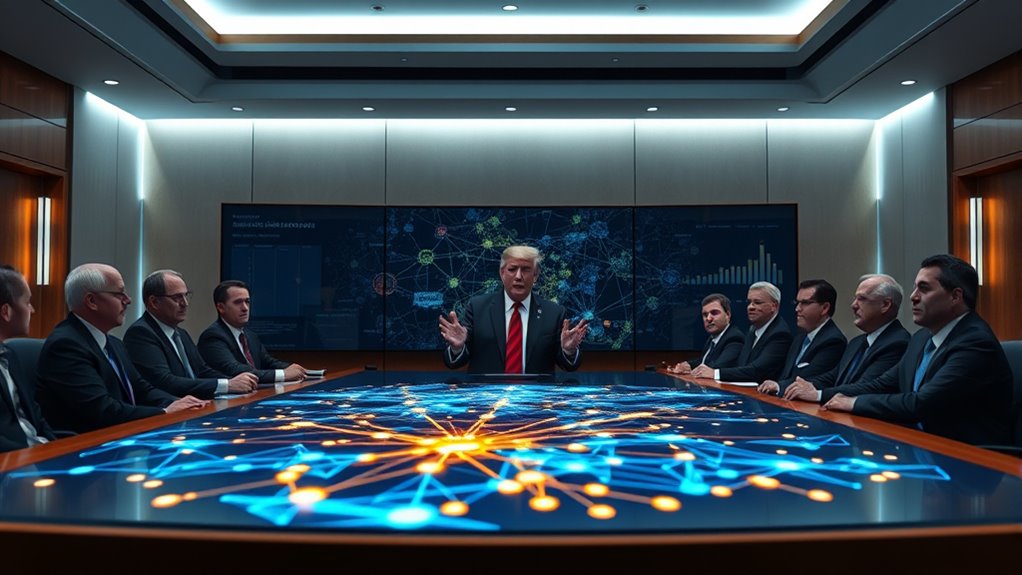You find that Trump established a Crypto Task Force and issued an executive order to overhaul U.S. digital asset policies. This effort aimed to balance fostering innovation with preventing fraud, money laundering, and misuse. The task force worked to create clear regulations that support growth while safeguarding consumers and the financial system. If you want to understand how these initiatives are shaping future policies, there’s more to discover beyond the surface.
Key Takeaways
- The Crypto Task Force was established during Trump’s presidency to evaluate and recommend cryptocurrency regulations.
- The Executive Order directed federal agencies to coordinate efforts and develop adaptable digital asset guidelines.
- The initiative aimed to balance fostering innovation with preventing fraud, money laundering, and consumer risks.
- The policy overhaul focused on creating a clear regulatory framework to support responsible blockchain and crypto development.
- It emphasized proactive, unified efforts to safeguard the financial system and encourage responsible innovation.

During his presidency, Donald Trump took significant steps to shape the future of cryptocurrency regulation by establishing a dedicated crypto task force and issuing an executive order. This move signaled a recognition of the growing importance of digital assets and aimed to address the complex regulatory landscape. As you explore this shift, you’ll notice that the primary focus was on managing the regulatory challenges that cryptocurrencies pose to existing financial systems. The government faced issues like fraud prevention, money laundering risks, and consumer protection, which required a clear framework to prevent misuse while fostering legitimate innovation. The task force was tasked with evaluating current laws, identifying gaps, and recommending policies that could help balance regulation with growth. This effort wasn’t just about control; it was also about creating a space where innovation opportunities could flourish without unchecked risks. By doing so, the administration aimed to prevent regulatory overreach that might stifle technological progress, while also setting boundaries to protect investors and the economy. Additionally, establishing clear guidelines can help mitigate the regulatory challenges associated with emerging digital assets.
The executive order issued by Trump further underscored this approach, emphasizing the need for an all-encompassing strategy to oversee digital assets. It directed federal agencies to coordinate efforts, share information, and develop guidelines that could adapt to the rapidly evolving crypto landscape. You should understand that this order was a proactive move—rather than waiting for problems to escalate, it aimed to establish a foundation for responsible innovation. This approach encourages startups and established companies to explore blockchain and cryptocurrency solutions with clear regulatory signals, reducing uncertainties that can slow down development. It also aimed to mitigate illegal activities by setting standards for compliance, thereby safeguarding the financial system.
Frequently Asked Questions
How Will These Policies Affect Everyday Cryptocurrency Users?
These policies aim to bring more regulatory clarity, which means you’ll likely see clearer rules for using cryptocurrencies. This can lead to enhanced market stability, reducing risks and protecting your investments. You might experience fewer scams and frauds, making crypto transactions safer. While some new regulations could increase compliance costs, overall, these policies should foster a more secure and trustworthy environment for everyday users like you, encouraging wider adoption and confidence in digital currencies.
What Specific Cryptocurrencies Will Be Most Impacted?
You’ll find that major cryptocurrencies like Bitcoin and Ethereum experience the most regulatory impact, affecting their market stability. New policies aim to increase oversight, which could lead to fluctuations in their value and usage. As a user, stay informed about these changes, because increased regulation might mean more security but also potential restrictions. Your experience will depend on how these policies shape the overall market stability and the regulatory landscape.
Will There Be New Regulations for Crypto Exchanges?
A stitch in time saves nine, so you can expect new regulations for crypto exchanges soon. These regulations aim to provide regulatory clarity, helping protect investors and promote market stability. You’ll likely see stricter compliance requirements and increased oversight, making the trading environment safer. Staying informed and adaptable will be key as these changes roll out, ensuring you navigate the evolving landscape smoothly and securely.
How Does This Overhaul Compare to Previous Administrations?
Compared to previous administrations, this overhaul emphasizes stronger regulatory consistency and international cooperation. You’ll notice a more unified approach to crypto regulation, aiming to reduce gaps and ambiguities. The focus shifts towards aligning U.S. policies with global standards, making it easier for exchanges to operate smoothly across borders. This new direction seeks to foster innovation while ensuring security, transparency, and compliance, setting a clearer path forward for the crypto industry.
What Are the Long-Term Goals of the Crypto Policy Shift?
Your long-term goal with this crypto policy shift is to reduce regulatory uncertainty, making it easier for innovation incentives to flourish. You want to create a balanced framework that encourages technological advancements while maintaining security and consumer protection. By doing so, you aim to attract more blockchain and crypto startups, fostering economic growth and ensuring the U.S. remains competitive in the digital currency landscape well into the future.
Conclusion
As you watch these changes unfold, it’s almost like the pieces are falling into place naturally, shaping a new financial landscape. Trump’s crypto task force and executive order aren’t just policies—they feel like the start of something bigger, quietly steering the future. You might realize that, in this moment, all the pieces are aligning, hinting that the next chapter in U.S. crypto regulation is just around the corner, waiting to be written.








